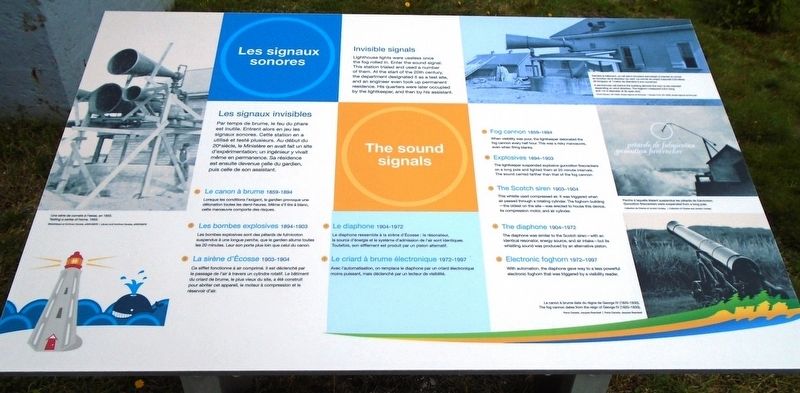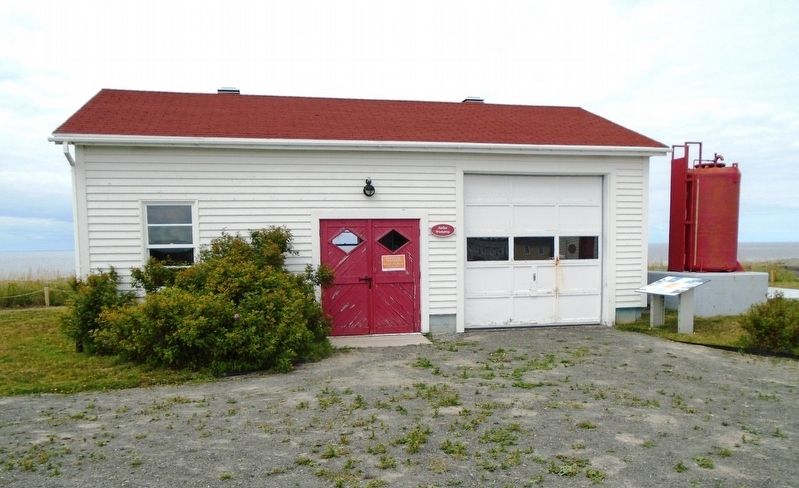Les signaux sonores / The sound signals
Les signaux invisibles
Par temps de brume, le feu du phare est inutile. Entrent alors en jeu les signaux sonores. Cette station en a utilisé et testé plusieurs. Au début du 20e siècle, le Ministère en avait fait un site d'expérimentation; un ingénieur y vivait même en permanence. Sa résidence est ensuite devenue celle du gardien, puis celle de son assistant.
1. Le canon à brume 1859-1894
Lorsque les conditions l'exigent, le gardien provoque une détonation toutes les demi-heures. Même s'il tire à blanc, cette manœuvre comporte des risques.
2. Les bombes explosives 1894-1903
Les bombes explosives sont des pétards de fulmicoton suspendus à une longue perche, que le gardien allume toutes les 20 minutes. Leur son porte plus loin que celui du canon.
3. La sirène d'Écosse 1903-1904
Ce sifflet fonctionne à air comprimé. Il est déclenché par le passage de l'air à travers un cylindre rotatif. Le bâtiment du criard de brume, le plus vieux du site, a été construit pour abriter cet appareil, le moteur à compression et le réservoir d'air.
4. Le diaphone 1904-1972
Le
5. Le criard à brume électronique 1972-1997
Avec l'automatisation, on remplace le diaphone par un criard électronique moins puissant, mais déclenché par un lecteur de visibilité.
[Légendes photo, dans le sens des aiguilles d'une montre, en partant du haut à gauche, lisez]
• Une série de cornets à l'essai, en 1903.
• Derrière le bâtiment, un rail semi-circulaire permettait d'orienter le cornet en fonction de la direction du vent. Le cornet du criard mesurait 3,6 mètres de longueur et 1 mètre de diamètre à son ouverture.
• Perche à laquelle étaient suspendus les pétards de fulmicoton.
• Le canon à brume date du règne de George IV (1820-1830).
Lighthouse lights were useless once the fog rolled in. Enter the sound signal. This station trialed and used a number of them. At the start of the 20th century, the department designated it as a test site, and an engineer even took up permanent residence. His quarters were later occupied by the lightkeeper, and then
1. Fog cannon 1859-1894
2. Explosives 1894-1903
3. The Scotch siren 1903-1904
4. The diaphone 1904-1972
5. Electronic foghorn 1972-1997
[Photo captions, clockwise from top left, read]
• A semicircular rail behind the building allowed the horn to be oriented depending on wind direction. The foghorn measured 3.6m long and 1m in diameter at its open end.
• Guncotton firecrackers were suspended from a long pole.
When visibility was poor, the lightkeeper detonated the fog cannon every half hour. This was a risky manoeuvre, even when firing blanks.
The lightkeeper suspended explosive guncotton firecrackers on a long pole and lighted them at 20 minute intervals. The sound carried farther than that of the fog cannon.
This whistle used compressed air. It was triggered when air passed through a rotating cylinder. The foghorn building—the oldest on the site—was erected to house this device, its compression motor, and air cylinder.
The diaphone was similar to the Scotch siren—with an identical resonator, energy source, and air intake—but its whistle sound was produced by an alternative piston.
With automation, the diaphone gave way to a less powerful electronic foghorn that was triggered by a visibility reader.
• Testing a series of horns, 1903.
Erected by Parks/Parcs Canada.
Topics. This historical marker is listed in these topic lists: Communications • Parks & Recreational Areas • Waterways & Vessels. A significant historical year for this entry is 1903.
Location. 48° 31.07′ N, 68° 28.093′ W. Marker is in Rimouski, Québec, in Rimouski-Neigette. Marker is on rue du Phare, on the left when traveling east. Marker is on the Pointe-au-Père Lighthouse station grounds. Touch for map. Marker is at or near this postal address: 1000 rue du Phare, Rimouski QC G5M 1L8, Canada. Touch for directions.
Other nearby markers. At least 8 other markers are within walking distance of this marker. Témoins de l'automatisation de la station de phare (a few steps from this marker); Les premices / In the beginning (a few steps from this marker); Bienvenue / Welcome (a few steps from this marker); Le hangar de la corne de brume / Fog Alarm Shed (a few steps from this marker); Les premiers phares / The first lighthouses (within shouting distance of this marker); Modernisation / Modernizing (within shouting distance of this marker); Innovation (within shouting distance of this marker); L'épave du/The Wreck of RMS Empress of Ireland (within shouting distance of this marker). Touch for a list and map of all markers in Rimouski.
Related marker. Click here for another marker that is related to this marker.
Also see . . .
1. Foghorn (Fog signals). Wikipedia entry (Submitted on November 16, 2023, by Larry Gertner of New York, New York.)
2. Discover Pointe-au-Père Lighthouse National Historic Site. Parks Canada website entry (Submitted on December 25, 2018, by William Fischer, Jr. of Scranton, Pennsylvania.)
3. Lieu historique national du Canada du Phare-de-Pointe-au-Père. Parks Canada website entry (Submitted on December 25, 2018, by William Fischer, Jr. of Scranton, Pennsylvania.)
4. Pointe-au-Père Lighthouse Heritage Lighthouse. Parks Canada website entry (Submitted on December 25, 2018, by William Fischer, Jr. of Scranton, Pennsylvania.)
Credits. This page was last revised on November 16, 2023. It was originally submitted on December 25, 2018, by William Fischer, Jr. of Scranton, Pennsylvania. This page has been viewed 197 times since then and 16 times this year. Photos: 1, 2. submitted on December 25, 2018, by William Fischer, Jr. of Scranton, Pennsylvania.

